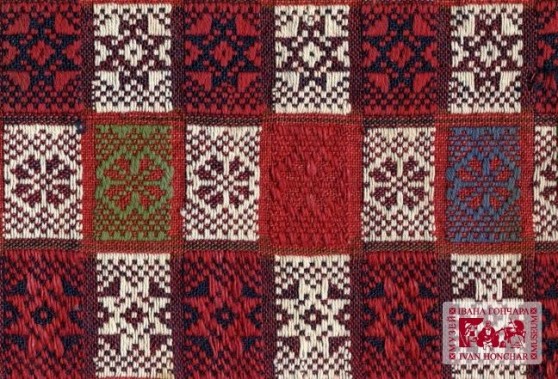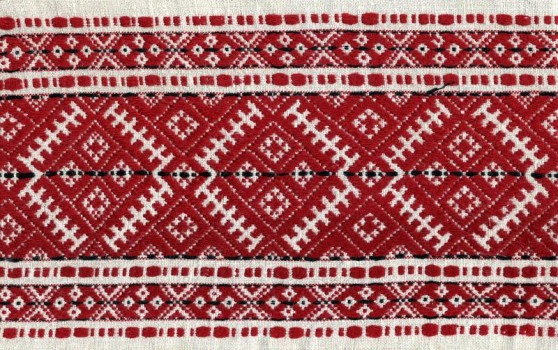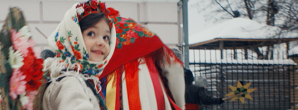-
 About & contacts
About & contacts
-
 Events
Events
-
 Web-project “Ukrainian culture”
Web-project “Ukrainian culture”
-
 Museum’s mission statement
Museum’s mission statement
-
 Exposition
Exposition
-
 Collection
Collection
-
 Ivan Honchar’s library
Ivan Honchar’s library
-
 Typical Ukrainians in the paintings of Ivan Honchar
Typical Ukrainians in the paintings of Ivan Honchar
-
 Ivan Honchar’s picturesque Ukraine
Ivan Honchar’s picturesque Ukraine
-
 Oasis of Ukrainian culture — Ivan Honchar Museum
Oasis of Ukrainian culture — Ivan Honchar Museum
-
 From the Guest book (1962-1988)
From the Guest book (1962-1988)
Today, the museum collections hold close to 30,000 artifacts of folk art, material culture, and rare books. Among the artifacts are: embroidered towels (which in Ukrainian life traditionally were used for many sacral purposes), rugs, clothes, head gear, pottery of many kinds, earthenware, toys, painted Easter eggs, wood carvings, folk musical instruments, naïve art paintings; sculpture, and icons created by folk artists. The fine arts are represented by paintings and graphic works. Honchar’s private library of about 3,000 volumes became part of the museum too. Many of the books are Ukrainian incunabula and other rarities. A lot of books are of the kind that in the Soviet times were kept in the “special depositaries”, and possession of which could land the possessor in prison. Of a great scholarly value are Honchar’s archives which include manuscripts (Honchar’s and of other authors); letters; diaries; tapes and photographs. Honchar’s own works make up a considerable part of the museum’s collection – there are about one thousand paintings in it and about six hundred pieces of sculpture. Complementing this collection, and not as known to the general public, are over 20,000 historic and documentary photographs of the turn of the 20th century. A portion of these are included in the eighteen volumes of the Honchar’s historic-ethnographical album Ukraine and Ukrainians.
Textiles and clothing
Textiles and clothing in the collections of the national center of folk culture “Ivan Honchar Museum”
In his collecting, Ivan Honchar devoted much attention to rushnyky [pl., rushnyk, sing. – ritual cloths], folk costume, and textiles intended for interior use. As of January 1, 2006, the collection of the Textile Department of the Museum holds 3,710 items. Of these, 2,605 are from Honchar’s original collection. In the twelve years of its existence, the Ivan Honchar Museum increased its textile holdings by 1105 more articles.
Rushnyky constitute the largest and most interesting group in this department – over 1,000, with one-third of these embroidered, the rest woven. Rushnyky are an integral part of Ukrainian life, and ritually accompany a person from birth to death. A rushnyk (sing.) is a rectangular piece of linen or hempen home-spun and home-woven cloth, with embroidered or woven ornamentation on the short edges, although sometimes the designs could cover the whole surface. These symbolic ornaments and signs represent the path for life and its good fortune and bliss. The role of rushnyky in rituals and traditions is unsurpassed, because they are an intermediary between God and people. For this reason, Ukrainian rushnyky are an integral part of the spiritual and material heritage of our people.
The Museum’s collection holds rushnyky representing all original historic-ethnographic regions of Ukraine: Central Dnipro region (Kyiv, Poltava, Chernihiv regions), Slobozhanshchyna (northeastern Ukraine), Podillia, Polissia, and the Carpathian region. The oldest rushnyky in the collection are from the Poltava region, dating from the 18th century. Among them those embroidered with archaic compositions of various ornaments. Apart from the rushnyky of Poltava, interesting groups of embroidered rushnyky are the “Obukhiv” and “chernyts’ki” [embroidered by nuns] ones from the southern Kyiv region (presently Cherkasy region), and those from Podillia and Chernihiv. The major portion of embroidered rushnyky in the collection was used in weddings, because so many of them were prepared specifically for this purpose far in advance.
The woven rushnyky of the Chernihiv region are very interesting, having varied complicated ornamental compositions. The “krolevets’ki” rushnyky form a notable group (over 100 items). These were popular in Central Ukraine thanks to their commercial production in the city of Krolevets’. They were developed from the folk weaving tradition of the Chernihiv region.
The folk costume collection of the Museum holds over 1,000 items. The complete Ukrainian folk costume is extremely varied, and the variations are a result of historic-ethnographic regions, the seasons, local raw materials, social status, and other influences. An integral component of both the male and female costume is the sorochka [shirt, sing.], of which there are approximately 500 in the collection. The everyday sorochky [pl.] were sewn from thicker linen or hempen cloth, and modestly decorated. The women’s sorochky for festive occasions are richly embroidered on the sleeves, bodice, and along the hem [women’s sorochky are full-length, to the ankle]. A typical feature of the Ukrainian sorochka is that it is sewn from white cloth. The more it is naturally bleached to white, the better. One of the most archaic modes of embroidery is white embroidery in well sun-bleached hand-spun linen or hempen threads, later commercial cotton threads. White-on-white embroidery is typical of all regions of Ukraine, because our ancestors belonged to the fair, Indo-European civilization which held the white color in great respect, as it represented light, fire, and the Sun. White, as the color of power, purity, and harmony, was widely present in the sun-bleached sorochky, rushnyky, svyty [home-woven outerwear], as well as in internally and externally white-washed village houses. In addition to the ubiquitous white embroidery, other colored threads were employed: red (especially in Polissia), black (mostly in Podillia), red and black, and red and blue, both combinations typical of all historic-ethnographic regions. The ornamental compositions and colors of embroidered Ukrainian sorochky have their origins in deep antiquity.
Outerwear in the collection is represented by svyty [cloaks], serdaky [jackets], and iupky [women’s sleeveless outerwear] – sewn from woolen home-spun and home-woven felt-finished cloth, in white, grey, and dark brown. The patterns and ornamentation are varied, but basically are tunic-style, the oldest and most common basic clothing pattern around the world.
Clothing for the upper body is comprised of vests in various lengths – bezrukavky, kersetky, keptari, kamizel’ky, etc. Keptari [pl., keptar, sing.] are worn mainly in the Carpathian region, and are especially rich. They are made of sheepskin, with the fur on the inside, trimmed along the edges with Persian lamb, or marten, fox, or fitchet. The ornate ornamentation is done in embroidery, cord, braid, copper work, and appliqué.
Lower body clothing in the collections includes women’s attire: plakhty [pl., plakhta, sing.], litnyky [pl., litnyk, sing.], spidnytsi [pl., spidnytsia, sing.], zapasky [pl., zapaska, sing.], fartukhy [pl., fartukh, sing.]. The collection of plakhty from the Kyiv, Chernihiv, and Poltava regions is especially interesting, as plakhty belong to the most archaic type of wrap skirt. The plakhta fabric is woven in ornamented squares, which symbolized for our ancient agricultural ancestors the sown, thus fertile, field. In addition, the wrap-styled plakhta helps the pregnant woman carry and protect her unborn children. Also serving as protection for the child-bearing loins are the woolen woven zapasky and linen or hempen fartukhy (aprons), without which a woman would not leave her home. Varieties of men’s pants included shtany, sharovary (very wide gathered pants) and hachi (woolen pants).
Both men and women tied their waists with sashes – poias or kraika – which were especially ornately woven in Podillia, Bukovyna, Pokuttia, and the Hutsul regions. Most krayky [pl.] throughout Ukraine were woven in length-wise multicolored patterned striped designs. The sash is not just a practical and ornamental accessory – it is also a talisman protecting the center of the body. In addition to the woven sashes, there are also plaited ones from the Kyiv, Podillia, Poltava, Chernihiv, and Volyn regions.
Women’s headcovering in the collections includes ochipky [pl., ochipok, sing.], namitky [p., namitka, sing.], khustky [pl., khustka, khustka, sing.], vinky [pl., vinok, sing.]. Men’s headcovering includes straw, sheepskin, and felt hats.
In addition to complete costumes, the Textile department of the Museum holds over 700 samples of embroidery from clothing, rushnyky, etc. Most of these are for research, and are part of the academic support section of the Museum. They are also utilized in the work of the “Oriana” Studio of Ukrainian Folk Embroidery, which offers a two-year course (weekly sessions) in embroidery, covering approximately 200 stitches in 20 embroidery techniques. In addition to the practical lessons, students learn about the colors, ornamentation, symbolism, and patterns of the Ukrainian folk costume.
Yuriy MELNYCHUK,
Senior Researcher, Ivan Honchar Museum


























